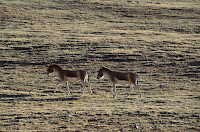Salvete Omnes,
sad moment for the Polish-Saxon kings collection held at the Dresden Castle, state of Saxony, German Federal Republic - yesterday, circa 5AM there was a robbery in there.
Das Grünes Gewölbe or Zielone Sklepienie (
the Green Vault) - started in AD 1723 by our king Augustus II the Strong(and Unlucky should be added too) - was robbed in a daring or astonishing act of thievery.
As usually when comes to reporting crime in Germany very little is known, but it appears that two men broke into the Green Vault and took what they came for. An inside job?
There is no precise info what and how much was stolen. It appears that he protections at the vault were more or less laughable considering the treasures it held.
The famous green diamond, the largest in the world and originally bought by our king Augustus III, was away at the MET, in NYC - thank God
The artwork stolen is priceless, but broken into pieces is worth millions or even billions of dollars.

now, one more matter:
I would like to point to you that the reporting in many English language worldwide media outlets (eg
here, or
here- BBC no less-, or
here - CNN the friends of Poland , or
here they say that he was 'later a king of Poland') indicate that the collection was started by Augustus II the Strong, elector of Saxony, and they do not mention that he was first and foremost the king of Polish-Lithuanian Commonwealth and that he draw his wealth from his kingship, and that when he started the collection he had been already more than 20 years the ruler of our Polish state.
a little chronology of Augustus II der Starke reign:
1694 - elector of Saxony
1697 - elected by the Polish nobles as the king of Polish-Lithuanian commonwealth
1733 - died in Warsaw, Polish-Lithuanian Commonwealth
Is this English language world media willful, orchestrated omission of Polish history and heritage or a simple case of ignorance and lack of education?
one must ponder - IMHO this is the very failure of the Polish institutions and scholars to educate the world, in spite of the Polish history foundations at many of the American, British and Canadian universities - perhaps wrong people sit there; time to change the appointments.
valete
[in Polish]
Zielone Sklepienie okradzione -
artykul z Deutsche Welle.



















































